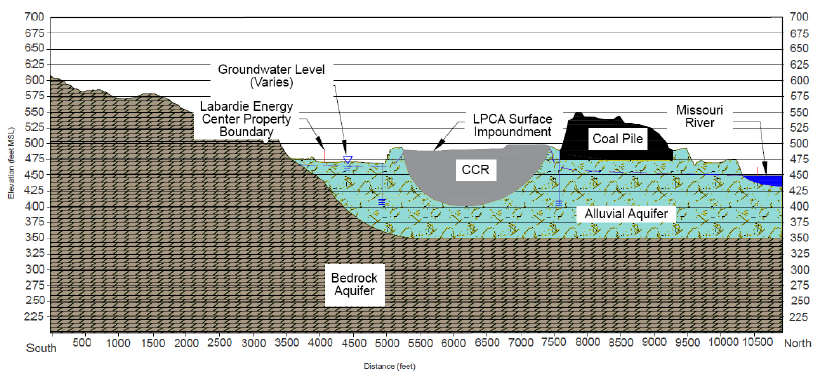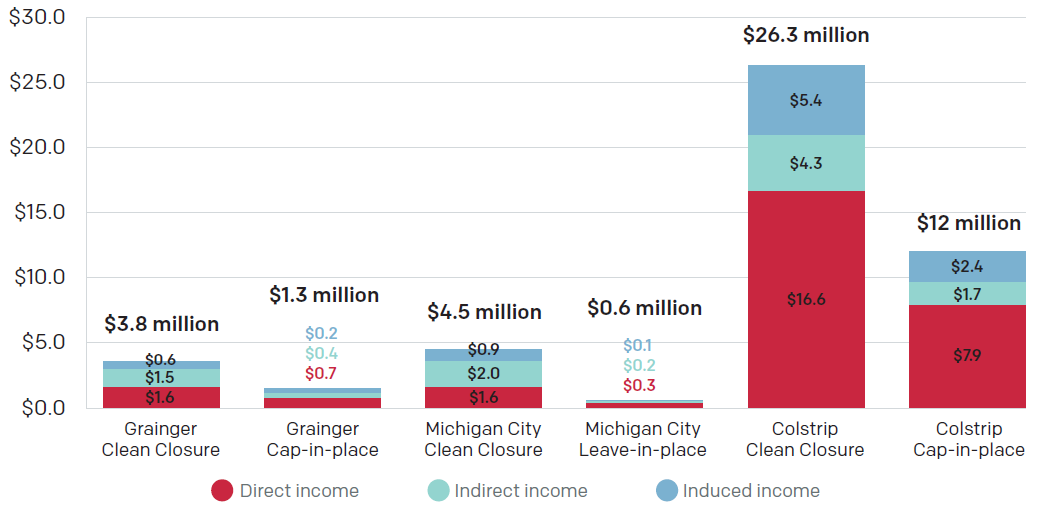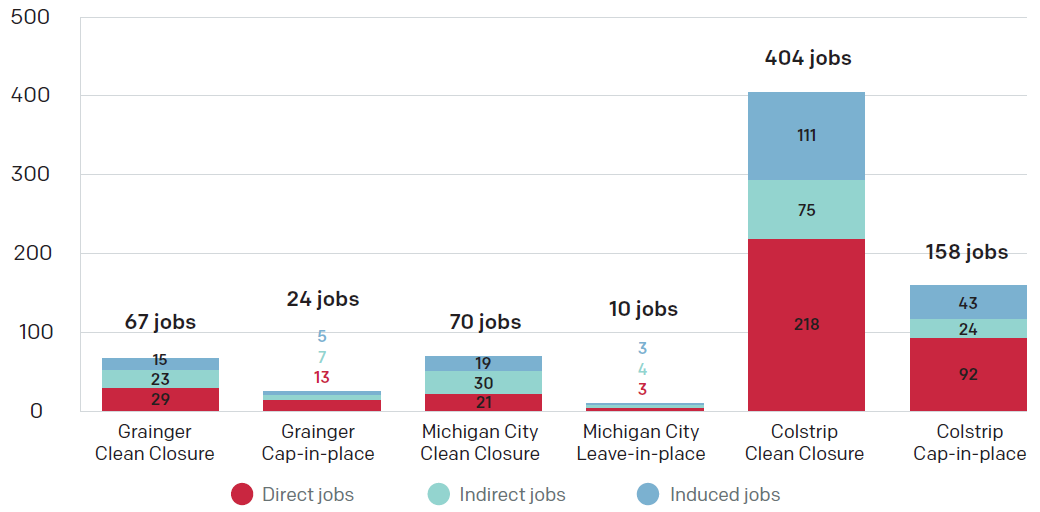July 8, 2021
Cleaning Up Coal Ash For Good: Resources and Recommendations
The report "Cleaning Up Coal Ash For Good" provides an analysis of closure and cleanup of coal ash ponds located at three coal-fired power plants in the U.S. Economists and environmental engineers compared the benefits, cost, and direct job creation of thoroughly removing the toxic pollution versus leaving the ash in place with a cap to cover it.
What is coal ash?
Coal combustion residuals or “coal ash” is the toxic waste generated by the burning of coal.
Coal ash is one of the largest industrial waste streams in the U.S. and includes fly ash, bottom ash, boiler slag, and flue gas desulfurization sludge.
Read the report:
- Cleaning Up Coal Ash for Good: Economists and engineers document benefits of clean closure
Read analysis by the experts who prepared three technical studies as part of the report:
- Coal Combustion Residual Closure Analysis: Cost and Jobs Associated with Different Closure Alternatives, KirK Engineering & Natural Resources, Inc. 153 pp. (About this analysis)
- Background Report: Benefits Coal Ash Cleanup and Remediation, Applied Economics Clinic. Authors: Joshua Castigliego, Tyler Comings, Sagal Alisalad and Elizabeth Stanton, PhD. 29 pp. (About this analysis)
- Reuse and Economics Impacts: NIPSCO Power Generation Facility, Michigan City, IN, KirK Engineering & Natural Resources, Inc. 18 pp. (About this analysis)
The findings and recommendations in this report will help regulators, policymakers, and communities choose effective coal ash pond closures that protect the environment and public health while also creating jobs and benefiting the economy.
The plants evaluated include:
- Michigan City Generating Station (MCGS) in Indiana
- Grainger Generating Station in South Carolina
- Colstrip Stream Electric Station in Montana
In each case, the job creation, economic activity, and environmental benefits are far greater for clean closure than for cap-in-place.
Across the U.S., nearly all coal-burning power plants have severely contaminated groundwater by disposing of their toxic ash in leaking impoundments and landfills.
The pressing problem of how to clean up these contaminated sites is a high-stakes question for communities near coal plants.
When comparing the economic, environmental, and community impacts of different closure methods, this analysis finds that there are significantly higher benefits from a clean closure when all ash is removed from leaking ponds and the local community is engaged in closure and redevelopment planning processes.
Hundreds of coal ash ponds must be closed over the next several years, and many plant owners are proposing inadequate and sometimes illegal and dangerous closures.
To make matters worse, federal and state regulators often fail to provide oversight and are willing to rubber stamp industry plans.
The method of coal pond closure can have huge impacts on the health and economy of the host community. There are two primary ways to close coal ash impoundments:
- Clean closure: Entirely removing the ash from the waste pond
- Cap-in-place: Draining the surface water and capping the pond with the toxic waste still in place
The coal power industry has shown a preference for cap-in-place closure of coal ash waste ponds, because it is easier to implement as well as relatively low cost
Cap-in-place closure, however, does not prevent leaching by groundwater contact with coal ash underneath the cap, if the ash in the impoundment is in contact with the aquifer. And if coal ash is left in contact with groundwater, toxic contaminants will continue to leach into water in perpetuity.
Cap-in-place also leaves coal ash surface impoundments permanently vulnerable to catastrophic failure due to floods or cap failure during extreme storms.

Clean closure of coal ash ponds is a more thorough process that employs more people and therefore leads to greater wages and spending in the community.
A clean closure approach includes excavation and removal of coal ash either to a landfill compliant with federal regulations or for beneficial reuse as a raw material in products such as concrete or drywall.
Removal of coal ash typically mitigates both the source of groundwater pollution and the risk of catastrophic spills from impoundment failures due to floods or other extreme weather eventss.
Clean closure removes coal ash from contact with groundwater, thereby protecting drinking water, and moves it away from waterbodies, which is a permanent solution to water pollution and which allows restoration of wetlands, rivers, streams, and lakes.
The recommendations below are aimed at ensuring that proper closure and cleanup are carried out at every coal ash site in the United States.
Recommendations
The U.S. Environmental Protection Agency must:
- Enforce the 2015 federal CCR Rule’s prohibition on cap-in-place closure when the coal ash impoundment is in contact with groundwater. Failure to enforce this provision is resulting in the closure of toxic dumps in groundwater, ensuring that hazardous chemicals will continue to leak into water in perpetuity.
- Enforce the CCR Rule’s prohibition on cap-in-place closure when the coal ash waste pond is located in a floodplain and susceptible to floods that may destabilize the toxic pollution. Failure to enforce this provision will result in significant and long-term threats to water resources throughout the United States.
- Provide financial assistance to frontline communities through EPA’s Technical Assistance Services for Communities (TASC) Program or other grant programs to empower residents to participate meaningfully in the cleanup and closure of toxic coal ash dumps and achieve just transition.
- Provide oversight in communities where closure and cleanup are occurring to ensure coal ash excavation, transport, reuse and disposal are done safely and without the release of toxic contaminants to air, soil or water in the host communities, at the work sites, in communities along transport routes, and at the final disposal site. Excavation and transport of coal ash requires air monitoring and protective measures to prevent the inhalation of toxic ash by cleanup workers and nearby residents. Finally, ensure that final disposal does not disproportionately burden communities of color and low-income communities.
State and Local Officials must:
- Provide oversight and enforcement to ensure that the requirements of the 2015 CCR Rule are followed by all owners and operators in a timely manner. States have the authority to enforce all provisions of the CCR Rule, or equivalent state regulations, including the prohibition on leaving coal ash in groundwater and floodplains and the requirement to initiate a timely cleanup of contaminated groundwater.
- Provide support and resources to local communities. State and local officials must consider the local economic and environmental impacts of coal pond closures and assist communities in advocating for the most positive result.
The U.S. Congress must:
- Provide financial resources for just transition: The U.S. Congress must recognize that additional financial resources are needed in communities facing coal plant closures. Funding is imperative to ensure equitable and just transitions: it will enable affected communities to build capacity to meaningfully participate in the planning for site reuse, ensure workers are protected, and provide safe and healthy transitions of their environments and economies.
The Report
Acknowledgments
Executive Summary
Recommendations
Introduction
Background
Methodology
Findings
Community Case Study: Grainger Station (Conway, S.C.) – Excavation and reuse helps to prevent another coal ash disaster in the Southeast
Community Case Study: Michigan City Generating Station (Michigan City, Ind.) – The economic impacts and redevelopment opportunity of a true clean closure
Community Case Study: Colstrip Steam Electric Station (Colstrip, Mont.) – Creating jobs and protecting agriculture
Conclusion
Endnotes
Technical Studies
- Coal Combustion Residual Closure Analysis: Cost and Jobs Associated with Different Closure Alternatives
KirK Engineering & Natural Resources, Inc. 153 pp.
This report by environmental engineers provides a detailed analysis of closure and cleanup of coal ash located at three different coal plants located in Montana, South Carolina, and Indiana, evaluating the benefits, cost, and direct job creation under two differing closure plans for each facility. - Background Report: Benefits Coal Ash Cleanup and Remediation
Applied Economics Clinic. Authors: Joshua Castigliego, Tyler Comings, Sagal Alisalad and Elizabeth Stanton, PhD. 29 pp.
This report by a team of economists estimates the economic benefits associated with coal ash cleanup and remediation at the three power plants analyzed by KirK Engineering & Natural Resources in Montana, South Carolina, and Indiana. AEC’s analyses presents the economic impacts of two cleanup options estimated using (1) descriptions and costs of cleanup and remediation activities developed by KirK Engineering & Natural Resources Inc. and (2) AEC custom analysis using the IMPLAN model. - Reuse and Economics Impacts: NIPSCO Power Generation Facility, Michigan City, IN
KirK Engineering & Natural Resources, Inc. 18 pp.
Through case studies, KirK Engineering & Natural Resources presents examples of community planning and redevelopment success stories at retired U.S. industrial facilities. The studies were selected based on the proposed redevelopment end use or the process used to engage a community in the redevelopment process. Based on these studies, the report presents recommendations and potential options for redevelopment of the Michigan City Generation Station.
We are grateful to KirK Engineering & Natural Resources, Inc., and the Applied Economics Clinic who provided the technical analysis for this report and whose contributions made this report possible.
This report was prepared by Lisa Evans and Kate French.
Invaluable research and support were provided by Western Organization of Resource Councils; Northern Plains Resource Council; Frank Holleman and Nick Torrey, Southern Environmental Law Center; Indra Frank, Hoosier Environmental Council; Jenny Harbine, Earthjustice; and the community advocates in Michigan City, IN, including Ashley Williams, La’Tonya Troutman and Susan Thomas of Just Transition NWI, and Nancy Moldenhauer, Chair, Michigan City Sustainability Commission; and Nancy Kolasa, former member People In Need of Environmental Safety (P.I.N.E.S.).
Responsibility for all mistakes rests solely with the author. All views and opinions expressed in this report are those of Earthjustice and do not necessarily reflect the views of Earthjustice’s funders.
Media Inquiries: Kathryn McGrath, kmcgrath@earthjustice.org, @kathrynmcg
Earthjustice’s Clean Energy Program uses the power of the law and the strength of partnership to accelerate the transition to 100% clean energy.


